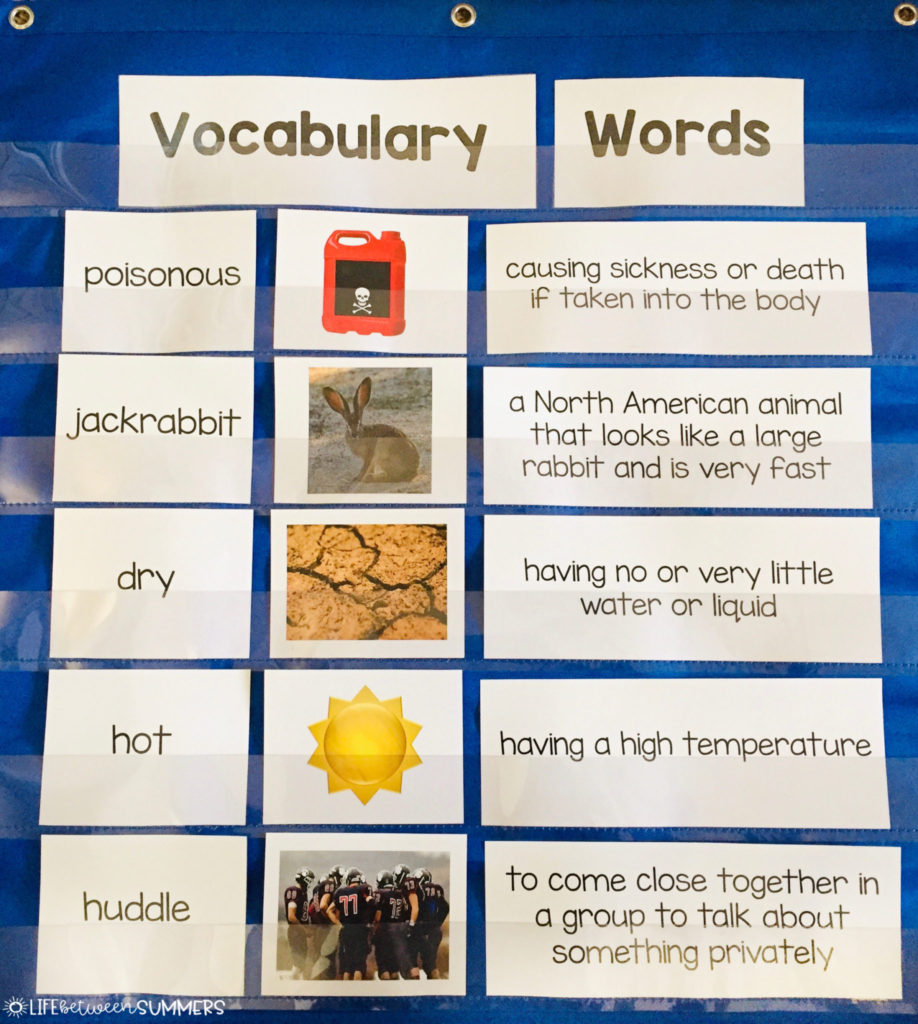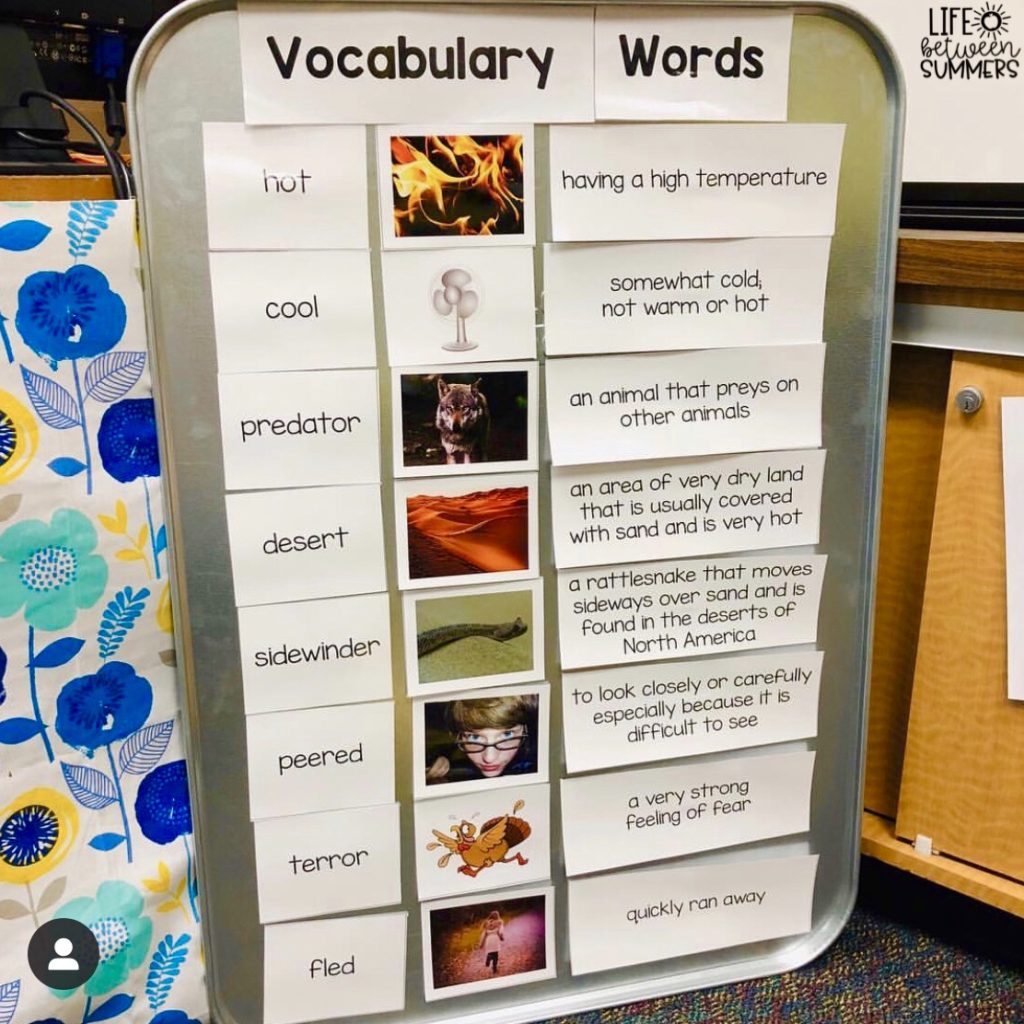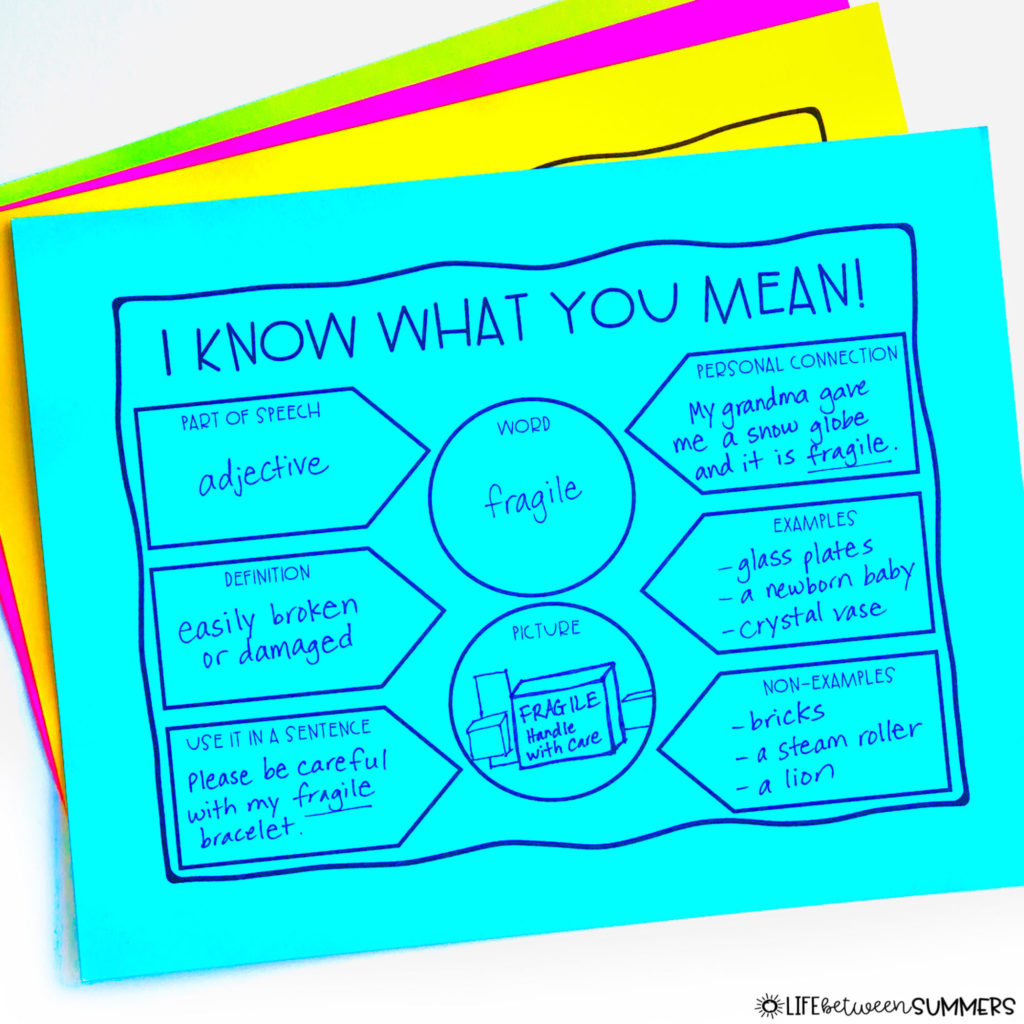Back when I was a student, there is only one vocabulary activity I can ever remember doing in class or for homework. It was looking up the word in the dictionary, writing the definition, and using the word in a sentence. I can recall this assignment itself (probably because of the sheer number of times I had to do it), but ask me how many of those actual words I am able to remember. Couldn’t tell you a single one, to be honest!
I like to think that we (teachers) are better than this. Have you ever seen the movie “Crazy Stupid Love?” There’s a part where Ryan Gosling’s character is giving Steve Carell a wardrobe makeover and he says, “Be better than the Gap!” Funny enough, this same sentiment applies to vocabulary lessons. “Be better than just writing the word, the definition, and a sentence!”
Given how important vocabulary is for reading comprehension, writing, and speaking and listening skills, it’s essential that we make it engaging for kids so that it actually sticks! If you are in need of some ways to spice up vocabulary practice in your own classroom, I’ve compiled a list of vocabulary strategies, games, and activities below. Hopefully you can snag a new idea (or five!)
1. Visuals, Visuals, Visuals!
Before I jump straight into the fun stuff (games, etc.), I should back up a bit by saying that students will greatly benefit from having a visual reference that they can look to throughout any vocabulary activity they do. One most effective type of visual reference is to simply have each vocabulary word displayed with a representative picture and the meaning. I like to have the word, picture, and definition cut up into strips because of all of the possibilities you can do when they are cut in separate pieces (more on that later!)

These can be displayed in a pocket chart as shown above, or another option is to put magnetic tape on the back of each card and display them on a magnetic surface. An oil drip pan (sold here or in most automotive shops) is a great option, because it’s mobile! You can set the visual at the front of the room, at your small group table for guided reading, on the floor for literacy centers, etc.

Once these cards have been used to introduce the words and their meanings to students, let the games begin!
2. Guess the Word
For this game, the only materials you need are a timer and small strips of paper to write each vocabulary word on. Throw them into a small basket or any container for students to draw from.
Two teams play against each other. You can do the whole class divided into two large teams, or smaller groups with multiple games going on at the same time. The game is played in 3 rounds, or if preferred, any of the rounds can stand alone as an entire game.
Round 1: Verbal Clues! Round 1 is very similar to the game Taboo, except there’s no card with a list of words that someone is not allowed to say.
Set a 1 minute timer. One student stands up front and gives verbal clues to their team to try and guess the word. For example, if the vocabulary word was “habitat” a student might say, “This is where an animal lives” or “Snakes can live in the rain forest, and this is called their _______.” As soon as someone on their team guesses the word (you can either let them call out guesses or raise their hands to be called on), they go on to the next word and repeat. When the minute is up, count how many words the student was able to get their team to guess and give them 1 point for each. Then it is the opposing team’s turn. You can either end the round there, or have more students continue giving clues.
Round 2: One word clues! The second round is played much like Round 1, except now the clue can only be ONE WORD. For example, a one word clue for habitat might be “home.” Each team is given a point for how many words they can guess in 1 minute based on the one word clues from the representative for their team.
Round 3: Act it out! The final (and often favorite) round is played in the same format as the first 2 rounds, except that no verbal clues are given. Students have to silently act out the word with motions, just like in a game of charades, to get their team to guess as many words as they can in one minute.
Tally up all of the points from all 3 rounds, and congratulate the winning team. And, congratulate yourself on helping your entire class thoroughly grasp the meaning of their vocabulary words!
Bonus Round: If you need a tie-breaker, or the kids are just so into it that you want to keep the game going, you can have a student draw a quick sketch on the white board to help their team guess the word (think Pictionary).
Variation: All rounds of this game can also be played the other way around, meaning that the audience gives the clues to one student. To play the game this way, the student at the front of the room turns their back and closes their eyes while you show the rest of the class a card with a vocabulary word on it. The student then opens their eyes, and calls on someone from their team who is raising their hand. That team member, depending on the round, tells them a clue, gives them a 1 word clue, or silently acts out the word (or draws a picture on their mini white board). Tally up how many words that student is able to guess from their team, and then switch teams.
Kids LOVE Guess the Word. It’s entertaining, competitive, and they get so engaged! It’s actually a twist on a party game that can be played with adults. Everyone writes down different words or phrase (usually silly ones) on a few strips of paper and they get thrown into a hat. It’s known as “Best Game Ever” among my own circle of friends, because it’s hilarious! I have often cried from laughing so hard. When there’s a fun factor for grown ups, it’s easy to see the potential for kids to have a great time with it too!
3. Group Up
I mentioned above that there are perks to having vocabulary word, picture, and definition cards cut up. One said benefit is that the strips can be used for a simple activity that gets students up and moving out of their seats. Give each student in your class a card (you can have pairs of students share a card or give a student an extra card if you have more or less students than the number of cards). Have students walk around the room and try to find the other people who have the card with the matching word, picture, or definition. Come back together as a whole class and call groups up to place their cards back in the pocket chart or on the magnetic surface, reviewing each word as you go.
4. Mix and Match
Another simple activity you can do when the cards are cut up is a “Mix and Match” for early finishers, literacy centers, etc. Students take all of the cards out of the pocket chart (or off of the magnetic surface) and mix them up. Then they have to put them back up, matching each word, picture, and definition correctly.
5. I Know What You Mean!
This one pairs nicely with the Mix and Match activity described above. Once students have matched everything back up, you could have them complete a graphic organizer. There are all kinds of vocabulary organizers out there, and here is the one I use with my own class. Students do in fact write the word, definition, and sentence that I spoke so fondly of earlier, but there are also some new additions that can really help deepen their understanding. In particular, the “personal connection” piece can really help them relate the meaning of the word to their own lives, and the “examples” and “non-examples” allow them to put the words in context. You can run off a bunch of copies of these to use for centers, or put them in sheet protectors so that students can reuse them.

If you like the format of this organizer, you’re in luck, because it’s FREE! You can get it right here. If you don’t want to miss out on more freebies (and resources that are 50% off for the first 24 hours) you can also click here to follow me on TpT.
The vocabulary word, picture, and definition cards pictured above are available in my store too. If your language arts adoption is Benchmark Advance, these are a huge time saver! I made them to use in my own classroom to help supplement vocabulary instruction with the texts used in Benchmark. Cards are available for Units 1-10 in first grade, second grade, third grade, and fourth grade, individually by unit or in discounted bundles. All of my Benchmark vocabulary cards can also be found on TPT.
What are some of your favorite strategies for teaching vocabulary? I’m sure other teachers would love to hear your ideas, so feel free to share in the comments below!


Leave a Reply
You must be logged in to post a comment.